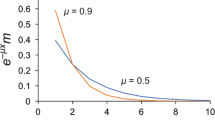Summary
The increased mortality caused by ageing represents a fitness cost to organisms. This paper develops techniques for determining the proportions of that cost that accrue at each age. A variety of analyses using several different sources of data on human ageing—palaeodemographic life tables and life tables from more recent societies with high mortality rates—all suggest that the ‘fitness cost’ of ageing was high during most of our evolutionary history, and was largely due to physiological changes occurring early in adult life. These results imply that predictions about the nature of senescence based on evolutionary theory should be tested using data from middle-aged individuals. They also have implications about the relative importances for human evolution of the ‘pleiotropy’ and ‘mutation-accumulation’ theories of the evolution of senescence, and for the validity of ‘Gompertz’ Law' for the shape of the relationship between mortality and age. An analysis of a life table of the African buffalo suggests that the costs of ageing early in adult life are relatively high in at least one non-human species in its natural environment.
Similar content being viewed by others
References
Acsadi, G. Y. and Nemeskeri, J. (1970)History of Human Life Span and Mortality. Akademiai Kiado, Budapest, Hungary.
Alexander, R. D. (1987).The Biology of Moral Systems. Aldine de Gruyter, NY, USA.
Ammerman, A. J., Cavalli-Sforza, L. L. and Wagener, D. K. (1976). Towards the estimation of population growth in Old World prehistory. InDemographic Anthropology: Quantitative Approaches (E. B. W. Zubrow, ed.), pp. 27–61, University of New Mexico Press, Albuquerque, NM, USA.
Bell, G. (1984) Evolutionary and nonevolutionary theories of senescence.Am. Nat. 124, 600–3.
Brown, J. L. (1986)Helping and Communal Breeding in Birds. Princeton University Press, Princeton, NJ, USA.
Caughley, G. (1966) Mortality patterns in mammals.Ecology 47, 906–18.
Charlesworth, B. (1980)Evolution in Age-structured Populations. Cambridge University Press, Cambridge, UK.
Charlesworth, B. and Leon, J. A. (1976) The relation of reproductive effort to age.Am. Nat. 110, 449–59.
Clutton-Brock, T. H. (1988)Reproductive Success. University of Chicago Press, Chicago, IL, USA.
Clutton-Brock, T. H., Guinness, F. E. and Albon, S. D. (1982) Red Deer: Behaviour and Ecology of two sexes. University of Chicago Press, Chicago, IL, USA.
Comfort, A. (1979)The Biology of Senescence, 3rd edn. Churchill Livingstone, Edinburgh, UK.
Economos, A. C. (1982) Rate of aging, rate of dying and the mechanism of mortality.Arch. Gerontol. Geriatr. 1, 3–27.
Gompertz, B. (1825) On the nature of the function expressive of the law of human mortality.Phil. Trans. 27, 513–9.
Grafen, A. (1984) Natural selection, kin selection, and group selection.Behavioural Ecology: An Evolutionary Approach (J. R. Krebs and N. B. Davies, eds), pp. 62–84. Sinauer, Sunderland, MA, USA.
Hamilton, W. D. (1966) The moulding of senescence by natural selection.J. Theor. Biol. 12, 12–45.
Hausman, P. B. and Weksler, M. E. (1985) Changes in the immune response with age. InBiology of Aging, 2nd edn. (C. E. Finch and E. L. Schneider, eds), pp. 414–32. Van Nostrand Reinhold, NY, USA.
Howell, H. (1979)Demography of the Dobe !Kung. Academic Press, NY, USA.
Keyfitz, N. and Flieger, W. (1968)World Population: An Analysis of Vital Data. University of Chicago Press, Chicago, IL, USA.
Kirkwood, T. B. L. (1981) Repair and its evolution: survival vs. reproduction.Physiological Ecology: An Evolutionary Approach to Resource Use. (C. R. Townshend and P. Calow, eds), pp. 165–89. Blackwell, Oxford, UK.
Kirkwood, T. B. L. (1985) Comparative and evolutionary aspects of longevity.Biology of Aging, 2nd edn. (C. E. Finch and E. L. Schneider, eds), pp. 27–44. Van Nostrand Reinhold, NY, USA.
Manton, K. G., Stallard, E. and Vaupel, J. W. (1986) Alternative models for the heterogeneity of mortality risks among the aged.J. Am. Stat. Assoc. 81, 635–44.
Medawar, P. B. (1952)An Unsolved Problem in Biology. H. K. Lewis, London, UK.
Miller, A. R. (1988) A set of life tables for theoretical gerontology.J. Gerontol. 43, B43–9.
Mueller, L. (1987) Evolution of accelerated senescence in laboratory populations ofDrosophila.Proc. Natl Acad. Sci. USA 84, 1974–7.
Nesse, R. M. (1988) Life table tests of evolutionary theories of senescence.Exp. Gerontol. 23, 445–53.
Newton, I. (1989)Lifetime Reproduction in Birds. Academic Press, New York, USA.
Preston, S. H. (1976)Mortality Patterns in National Populations. Academic Press, NY, USA.
Preston, S. H., Keyfitz, N. and Schoen, R. (1972)Causes of Death: Life Tables for National Populations. Seminar Press, NY, USA.
Promislow, D. E. L. (1990)Mortality Patterns in Mammals. D. Phil. Thesis, Oxford University, Oxford, UK.
Rose, M. R. (1985) The evolution of senescence. InEvolution: Essays in Honour of John Maynard Smith (P. H. Harvey and M. Slatkin, eds), pp. 117–29. Cambridge University Press, Cambridge, UK.
Schneider, E. L. and Reed, J. D. (1985) Modulations of aging processes. InBiology of Aging, 2nd edn (C. E. Finch and E. L. Schneider, eds), pp. 45–76, Van Nostrand Reinhold, NY, USA.
Shock, N. W. (1985) Longitudinal studies of aging in humans. InBiology of Aging, 2nd edn. (C. E. Finch and E. L. Schneider, eds), pp. 721–43. Van Nostrand Reinhold, NY, USA.
Sinclair, A. R. E. (1977)The African Buffalo: A Study of Resource Limitation of Populations, University of Chicago Press, Chicago, IL, USA.
Snowdon, D. A., Ostwald, S. K. and Kane, R. L. (1989) Education, survival and independence in elderly Catholic Sisters 1936–1988.Am. J. Epidemiol. 130, 999–1012.
Swedlund, A. C. and Armelegos, G. J. (1976)Demographic Anthropology. Wm. C. Brown, Dubuque, IO, USA.
Vaupel, J. W. and Yashin, A. I. (1985) Heterogeneity's Ruses: Some surprising effects of selection on population dynamics.Am. Stat. 39, 176–85.
Weiss, K. M. (1973)Demographic Models for Anthropology. Society for American Archeology, Washington, DC, USA.
Williams, G. C. (1957) Plelotropy, natural selection and the evolution of senescence.Evolution 11, 398–411.
Williams, G. C. (1966)Adaptation and Natural Selection. Princeton University Press, Princeton, NJ, USA.
Author information
Authors and Affiliations
Rights and permissions
About this article
Cite this article
Abrams, P.A. The fitness costs of senescence: The evolutionary importance of events in early adult life. Evol Ecol 5, 343–360 (1991). https://doi.org/10.1007/BF02214152
Issue Date:
DOI: https://doi.org/10.1007/BF02214152




